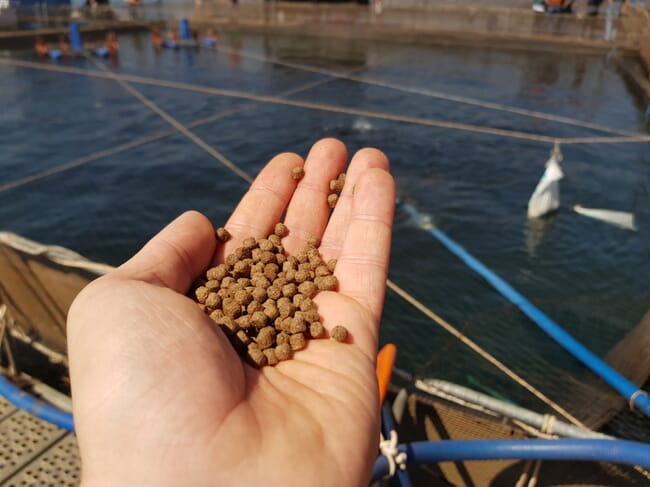
Feed is the number-one farming expense
Feed still stands out as aquaculture’s primary production expense – and the sector is on the look-out for ways to use it more efficiently. For many industry insiders, adopting “precision nutrition” – or feed that is formulated to unlock the potential of fish and crustacean DNA, microbiomes and metabolic responses to prevent disease and grow efficiently – is the next farming milestone. Like other areas of the industry, nutrition experts are turning to tech and research advancements to bring precision nutrition strategies online.
According to Dr Philip Lyons, Alltech’s global manager of aquaculture research, precision nutrition is on the industry’s far horizon – but this could soon change. At the recent Alltech One Conference, Lyons’ presentation, “Wave of the future: exciting new developments in aquatech” took delegates on a deep dive into the latest advancements in aquaculture nutrition– and the science that will bring them online.
The Phase 1 to Phase 8 model
Lyons began his presentation by graphing the different stages of tech use and innovations in animal protein production. The graph was broken down into eight distinct phases – with Phase 1 representing proteins that are made with minimal tech inputs or underlying research, and Phase 8 boasting production activities that are linked with big data and AI solutions. Lyons noted that though farmed terrestrial animals – like chickens, pigs and cows – are in Phases 7 and 8 of this graph, farmed aquatic species fall in Phases 3 to 4.
Lyons explained that the comparative tech saturation of the poultry and swine industries stems from a preliminary research advantage. Scientists in those sectors were exploring advances in a sole species. A single breakthrough could be disseminated widely and the dividends took a broad spectrum. Aquaculture doesn’t have that advantage. Currently, the industry is working with approximately 40 farmed species – all of which are at different R&D phases.
“We have the example of Atlantic salmon, Nile tilapia and rainbow trout – and you can see that they're sitting somewhere between Phase 4 and Phase 5 of this model,” Lyons said. “We can then compare that with less well-developed fish species like African catfish and European perch – and you can see that they're sitting somewhere between Phase 1 and Phase 2.”
Despite the uneven research attention, Lyons believes that the aquaculture sector is keen to apply research and tech solutions across farming activities. He told delegates that advancements within the nutrition segment – namely targeting precision nutrition – could take different fish species into Phase 5 or 6 on the research model. If researchers can develop fish diets that focus on net energy formulations, and create functional diets, aquaculture can progress and catch up with its peers in the terrestrial animal protein segment.
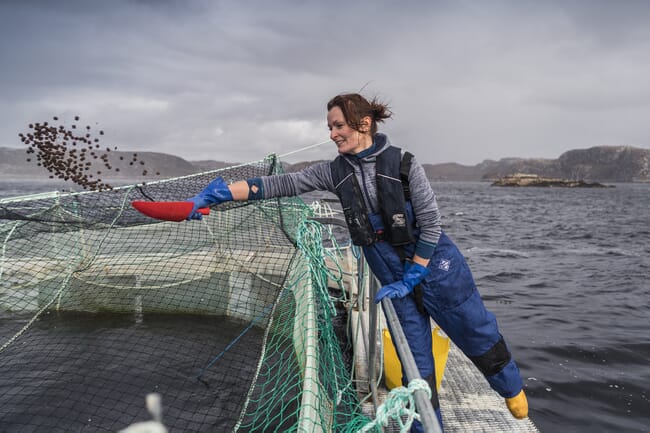
Creating functional diets and focusing on net energy formulations will advance the aquaculture nutrition sector © Loch Duart
Thinking beyond fishmeal replacement
“Fishmeal replacement is yesterday’s news,” Lyons began. “There are so many articles regarding single magic bullet ingredients that purport to replace fishmeal in aquaculture diets.” For Lyons, the next phase in precision nutrition will move beyond swapping marine ingredients for alternatives and involve using all the ingredients in our arsenal in flexible and sustainable ways. Ingredients that originate in the marine food web – like fish trimmings or byproducts – can still be part of the story, but the industry will probably embrace flexible formulations with multiple ingredients.
To make that shift and use feed ingredients more sustainably, the industry could adopt nutrition formulations that focus on net energy instead of digestible energy. The key difference between the two systems is that digestible energy assumes that all dietary macronutrients are used by the fish in the same way, while net energy assumes that the proteins, fats and carbohydrates in fish diets are processed differently. The focus on potential difference allows aquaculture nutritionists to develop feeds that are optimised for individual species – something that was difficult to do when relying solely on digestible energy metrics.
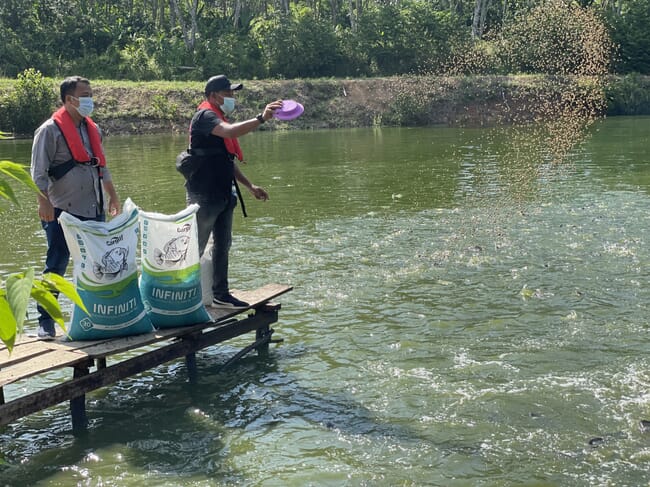
Switching to net energy feed formulations will allow the industry to create feeds that are tailored to individual species © Freddi Gaol, Minapoli
In the last two years, aquaculture nutritionists have been relatively successful in developing net energy models for different fish species. After Alltech created a feed for rainbow trout based on net energy metrics, Lyons noted that it allowed the company to be more flexible (read, economic and sustainable) in the raw materials they used. The new feed was also linked with stronger growth performance when compared to a control diet in a study published in the Journal of Animal Feed Science and Technology.
Enzymes and functional feeds
Lyons also highlighted the potential of enzymes in aquaculture nutrition. “I think [they’re] really an underutilised technology within fish feed, despite being commonly used in the pig and poultry sector,” he explained. In his role with Alltech, Lyons is including enzymes in extruded African catfish feed to improve phosphorous and carbohydrate digestibility. Using enzymes to improve phosphorous digestibility means that the fish will excrete less of the compound later in the cycle – ameliorating farm pollution.
When it comes to functional diets, Lyons believes that the industry will move to create feeds that are adapted to on-farm environmental conditions. This could mean developing feeds that remain digestible despite changing water temperatures.
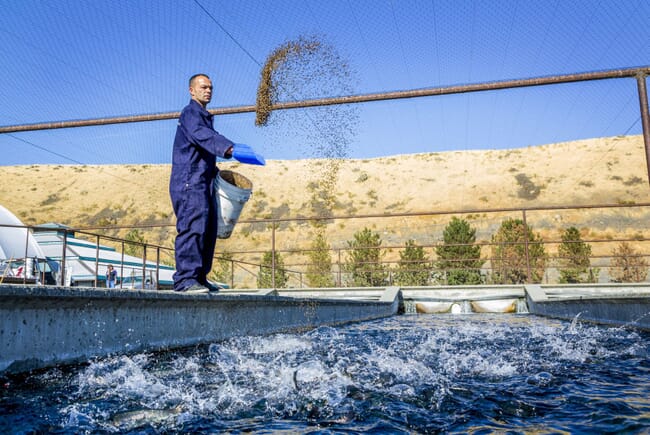
Aquaculture nutritionists could develop diets that have improved fat digestibility in cold temperatures – making them specific to winter conditions. © Hendrix Troutlodge
“In trout farming, water temperature can often drop as low as 4˚C to 6˚C [in the winter months],” Lyons began. When the water temperature drops, many trout producers opt to use their normal aquafeed – that usually has a high fat concentration. “As that fat then cools and solidifies according to the water temperature, it becomes more difficult for the fish to digest,” he explained. As the melting points of the fatty acid in the feed increases, the digestibility becomes lower. This effect is much more pronounced in cold water temperatures than warm ones.
Lyons explained that nutritionists could develop diets that have improved fat digestibility in cold temperatures – making them specific to winter conditions. In Alltech’s research trials with rainbow trout, Lyons noted that using this nutrition strategy yielded a 7 percent improvement in overall fat digestibility. It also translated into a lower feed conversion ratio (FCR) and improved growth performance during the winter months.
The gut microbiome and aquaculture
The role of the microbiome tends to be discussed at length at any industry and research conference – and for good reason. “This really still represents something of a black box within fish nutrition,” Lyons said. There’s been an explosion of publications that explore the gut microbiome in the aquaculture context in the last five years. Emerging genetic sequencing technologies have been able to map the microbial communities that live in the guts of more than 20 farmed fish species. But like industry conversations around feed ingredients, the focus of microbiome research is shifting.
Instead of focusing on, “who is there”, researchers are now asking, “what do they do?” – trying to determine the microbes’ functional contribution to fish nutrition. “In the future, we’re going to see a lot of studies that are moving away from profiling the membership of the gut microbial communities, to actually looking up their function or what their functional output is within the gut,” Lyons said.
This shift will shed light on lingering research questions like the link between microbial diversity and metabolite production – allowing the industry to establish baseline measures for gut health. Focussing on the function of the gut microbiome will also unlock advances in nutrient digestibility and fish performance. “I think [it will] provide big advances into carbohydrate nutrition …in fish in the coming years,” Lyons explained.
Where genetics and nutrition intersect
Lyons highlighted the role genetics can play in optimising aquaculture nutrition. Like animal agriculture, the aquaculture sector is banking on the promise of genetic improvements to make food production more efficient and sustainable. To date, most genetic selection techniques in aquaculture have targeted disease resistance or enhanced growth – but Lyons noted that researchers have recently targeted nutrient utilisation within single finfish species.
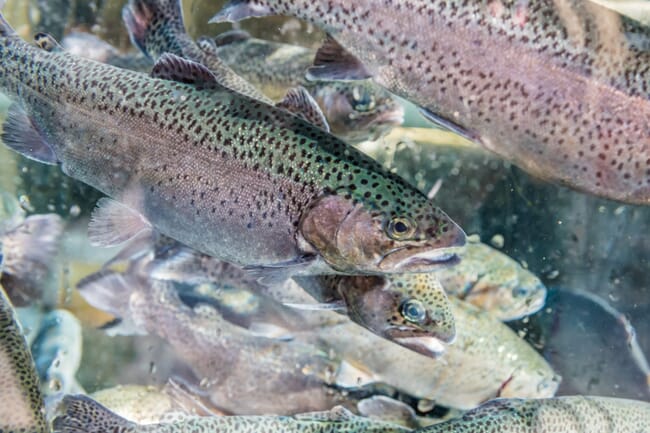
Researchers have recently targeted nutrient utilisation within single finfish species, allowing producers to feed fish to their genetic potential
Lyons showed data from a recent feed trial with rainbow trout that explored whether there were variations in feed uptake between two different genetic strains. Researchers had rainbow trout from a “fat” genetic strain and a “lean” genetic strain and fed them the same diet. The results showed significant differences in their nutrient utilisation.
Lyons noted that the fat strain had higher energy utilisation efficiency – the digestible energy intake vs the retained energy – than the lean strain. Trout from the fat strain were better able to absorb and metabolise the complex nutrients in their diets than those from the lean strain. If genetic effects are this pronounced, Lyons said that industry is looking at a new field of questions when it considers how it feeds farmed fish. “We’re no longer thinking [about] feeding trout as trout. We’re actually feeding to their genetic potential – or according to their genetic background,” he explained.
The importance of Phase 1
The industry’s nutrition knowledge base and progress towards implementing precision nutrition comes from early-stage research that defined key fundamentals like gross energy requirements and crude nutrients for different species. Atlantic salmon and rainbow trout nutrition appear to be leaps and bounds ahead of other farmed fish because researchers established these critical baselines and built on them. There’s no reason why European perch or African catfish couldn’t achieve this level of specialisation.
Lyons said that the early phases of research help establish critically important knowledge. This early stage needs to be followed by additional development efforts across multiple fish species. This will let the industries that support different farmed fish move closer to adopting advanced technologies. “The potential for novel scientific discoveries in fish nutrition and biology are essentially limitless,” Lyons concluded.




